
Central Platte NRD has sold 3,950,612 trees since 1972 and 633 miles of weed barrier since 1991.
Congratulations to the 2025 Gateway Expo winners. The following will receive 25 seedlings from Central Platte & Tri-Basin NRDs:
Lee Keefer, Russell, KS; Clarence Boston, Kearney; Nate Dillon, Cozad; Rob Novatne, Gibbon

Nebraska’s NRDs: Over 100 Million Trees Planted Since 1972!
Since 1972, Nebraska's Natural Resources Districts (NRDs) have partnered with landowners to plant over 100 million trees. This proud tradition continues through our Conservation Tree Program, designed to offer species of trees and shrubs ideal for windbreaks, wildlife habitats, and more. Our trees provide numerous benefits:
- Windbreaks to shield homes, crops, and livestock
- Wildlife habitats for food and shelter
- Soil protection to reduce erosion
- Energy savings by shading homes
- Noise buffering and landscape improvement
Order Your Trees: November 1 – April 1
Order your trees through our Conservation Tree Program from November 1 to April 1. Trees are delivered to the CPNRD office in Grand Island, stored in a climate-controlled cooler, and typically ready for pickup by mid-April. You will be notified when your order is ready for pickup at our office or your local NRCS office.
Cost
- Sold in bundles of 25
- $31.25 for 25 trees
- 50% Cost-share for trees & weed barrier. Minimum order of 200 trees to be eligible for cost-share funding.
- Order by December 31 to receive a 10% discount on trees, weed barrier and planting services.
Shrubs
American Hazelnut: Maximum height 8-10’. Best growth in moist soils. Produce tasty nuts within 3-5 years. Medium-fast growth rate.
American Plum: Medium-size. Forms dense thickets, ideal for windbreaks. White flowers bloom in May and red-purple plums ripen in September. Great for jellies.
Amur Maple: Medium/large-size shrub. Leaves turn scarlet during the fall. Drought tolerant. Use as outside row of windbreak.
Black Chokeberry: 3’-6’ tall. Berries (Aronia berries) can be canned or juice used for jelly making healthful fruit drinks. Best growth on low moist but well-drained sites in full sun.
Caragana: Large spreading shrub. Provides dense cover for wildlife. Adaptable to extreme cold/wind. Tolerates all soil. Ideal for shrub row in windbreak.
Chokecherry: Medium-size shrub. Use as outer row in windbreak. White flowers bloom in spring, cherries ripen during July. Great for making jelly and wine.
Common Lilac: Upright medium-size. Fragrant white to lavender flowers bloom in May. Use in outside row of windbreak.
Elderberry: Small shrub. Dark purple berries ripen in summer, excellent for jelly and syrups. Summer food source for wildlife.
False Indigo: Max height 5-20’. Thrives in moist soil that are poorly drained. Good for establishing wildlife food and cover on upland sites.
Golden Currant: Small native shrub. Winter-hardy and drought tolerant. Yellow flowers in May. Edible fruit. Excellent for wildlife and outside row of windbreak.
Peking Cotoneaster: Low-growing shrub. Dark-green foliage with brilliant red orange in fall. Berry-like fruit ripens in fall/winter. Outside row of windbreaks.
Red-Osier Dogwood: Medium to large-size shrub. Vivid red fall foliage, white flowers & berries. Best used in moist areas.
Serviceberry: Max height 25’. White flowers in spring followed by edible, sweet dark purple fruits in late June. Great for wildlife and windbreak plantings.
Sandcherry: Low-growing shrub, 4-6’ thickets. Produces sweet purple cherries, good for making jelly.
Silver Buffaloberry: Medium to large-size shrub. Thorny, tree-like shrub. Produces tart, fleshy berries used in jelly. Drought resistant.
Skunkbush Sumac: Medium-size shrub. It forms clusters of red berry-like fruit in the summer. Used as inside rows of windbreak.
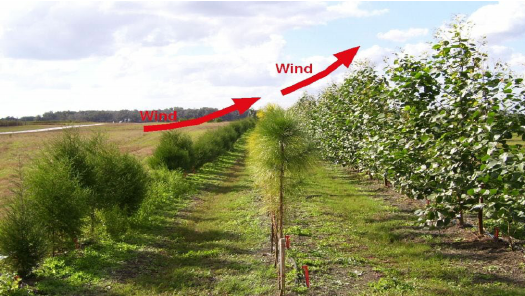 Deciduous Trees
Deciduous Trees
Black Cherry: Max height 35-40’. Valued for rich, reddish-brown wood for furniture. Fruit used for jelly and wine. Grows best on deep, moist, fertile soils.
Black Walnut: Max height 60-75’. Prized for rich chocolate- brown wood & nut meats. Requires deep, silty-loam soil with good drainage.
Bur Oak: Max height 60-80’. Grows on variety of soils, best grown on rich, moist bottom lands. Slow-moderate growth rate.
Catalpa: Max height 25-50’. Very fast-growing tree with large heart-shaped leaves. Prefers moist, deep, well-drained soils; will adapt to dry or wet soils.
Cottonwood: Max height 75-100’. Used for height in wind- breaks. Planted in riparian areas for filter strips near streams. Cottonless hybrids. Fast growth rate.
Hackberry: Max height 40-60’. Elm-shaped leaves grayish bark. Moderate tolerance to winter weather. Used in single row windbreaks.
Manchurian Apricot: Small spreading tree 15-20’. Pink flowers bloom in spring, produces fruit in fall. Outer row of windbreak.
Midwest Crabapple: Max height 20’. White blossoms in spring. Produces small apples for wildlife in fall/winter. Very hardy and disease resistant. Used in single row windbreaks.
Red Oak: Max height 60-75’. Foliage turns red to brown in fall. Fastest grower of the oaks. Known for dense, lustrous foliage.
Silver Maple: Max height 40’. Ideal for wet bottomland sites, great for filter strips next to streams. Fast growth rate.
Swamp White Oak: Max height 50-60’. Leaves are dark green on top/felty white bottom. Red bronze in the fall. Grows best on moist, bottomland forested soils.
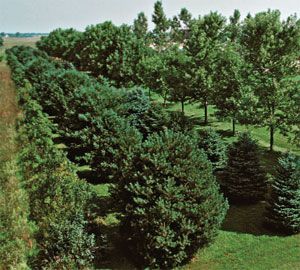 Conifers
Conifers
Black Hills Spruce: Variety of white spruce. Very dense, symmetrical with green needles. Used for landscapes, windbreaks & Christmas trees. Slower growing than Colorado Blue Spruce with shorter needles and more drought tolerant. Resistant to winter injury, insect/disease problems.
Colorado Blue Spruce: Max height 60-100’. Dark to silvery bluish green color. Forms very dense windbreak. Best used inside row of windbreak. Medium growth rate, long life span.
Eastern Red Cedar: Max height 15-20’. Best survival rate of any conifer in Nebraska. Drought resistant. Russet color foliage in winter. Primary species in windbreaks.
Jack Pine: 30’ tall with pyramidal form. Needles in pairs 1-2” long/Cones 1-1.5” long. Drought resistant, not recommended for limestone soils. Use on inside rows of windbreaks.
Norway Spruce: Max height 30-60’. Does well in humid, severe climates. Grows well in all soil types, prefers well-drained sandy loams. Provides winter cover for small wildlife.
Ponderosa Pine: Max. height 40-100’. Excellent windbreak, best used in east/south inside rows. Can withstand prolonged drought. Best pine choice for severe sites.
Rocky Mountain Juniper: Max. height 15-25’. Drought resistant, prefers alkaline soils. Best used on north/west outside rows in windbreaks. Retains bluish-green color in winter.
Visit the Conifer Encroachment website to learn about simple and effective solutions to conifer encroachment.
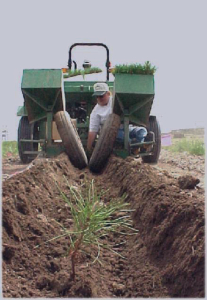 Tree Planting Service
Tree Planting Service
A complete tree planting service is available for orders of 200+ trees. Service includes a tree crew with all necessary equipment. When arrangements are made for the NRD to plant the trees, the tree planting crew will deliver them to the landowner at planting time.
Cost: $0.75/tree planted + tree cost
$300 Minimum charge
Site Preparation
Landowners are responsible for preparing the planting site. The area should be prepped as if planting a garden or field crop. Begin by plowing, followed by disking or rototilling, to create an ideal seedbed. Proper ground preparation is crucial for the survival of your trees. Autumn is the best time to start preparing the soil, as the winter weather helps the soil mellow, creating optimal conditions for spring planting.
District Planting Preparation & Guidelines
District Tree Planting Checklist
Ground Preparation
Prepare Your Land for Successful Tree Planting!
The success of tree planting begins with thorough ground preparation. Properly preparing the soil is essential to the survival of your trees, as well as for laying a weed barrier. When the ground isn't adequately prepared, it can be extremely challenging—if not impossible—for the NRD team to complete the planting process effectively.
This brochure provides detailed guidance on preparing your land for tree planting and weed barrier installation.
What does a properly prepared site look like?
The ground should be tilled at least 8” to 10” deep, ideally in the Fall before planting. The site is ready when it’s in a condition suitable for growing garden vegetables.
Landowner's Responsibility
While the NRD will contact “Diggers Hotline,” it's the landowner's responsibility to place the white marking flags to indicate the rows according to the NRCS planting plan.
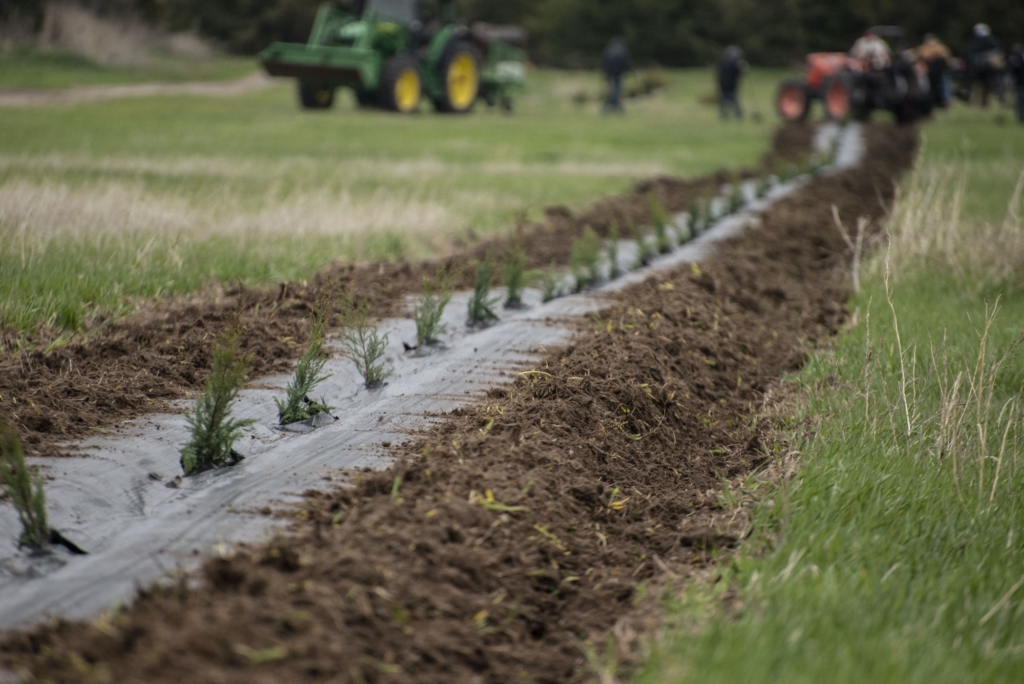 Fabric Weed Barrier
Fabric Weed Barrier
The fabric weed barrier provides long-lasting protection against weeds, offering a hassle-free solution without harming seedlings or the environment. Crafted from durable black polypropylene, this fabric resembles tightly woven burlap and is designed to allow water and nutrients to penetrate the soil effectively. With a guaranteed minimum service life of 5 years, this barrier ensures reliable performance, making it an excellent choice for maintaining a healthy windbreak or garden with minimal effort.
Products
Payment required when ordering.
- Fabric
$0.50/linear foot
6’ wide/you choose length (50’ minimum) - Sheets
$1.75/sheet | 4’x 4’ sheet - Staples
$3.75/bundle of 25 | 10”x 2”x 8” gauge - Fabric + Installation
$1.50/linear foot | 1,000 linear feet minimum Customer billed for actual number of linear feet installed when job is completed.
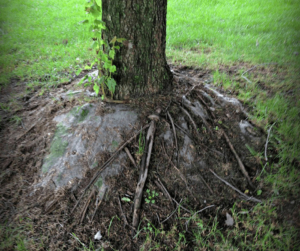 Girdling
Girdling
As your trees grow, it's important to cut the fabric back to allow the trunk to have sufficient space and to prevent girdling.
After a few years, check the trunks of your trees to ensure the fabric isn’t too close. As trees grow and their trunks expand, they may become larger than the original opening in the fabric. When the fabric begins to restrict the trunk, it causes girdling.
To prevent strangulation:
- Cut the fabric away from the trunks using a box cutter, pocket knife, or large pair of scissors.
- Take caution not to cut the trunk or injure yourself, as the fabric is made of a strong material.
-
Main Office
- 215 Kaufman Ave, Grand Island, NE 68803 308-385-6282
-
Cozad Office
- 75887 Road 414, Cozad, NE 69130 308-380-8943
-
NRCS Field Offices (Ext. 3)
- Central City 308-946-3035
- Kearney 308-237-3118
- Grand Island 308-395-8586
- Lexington 308-324-6314
- Osceola 402-747-2111




